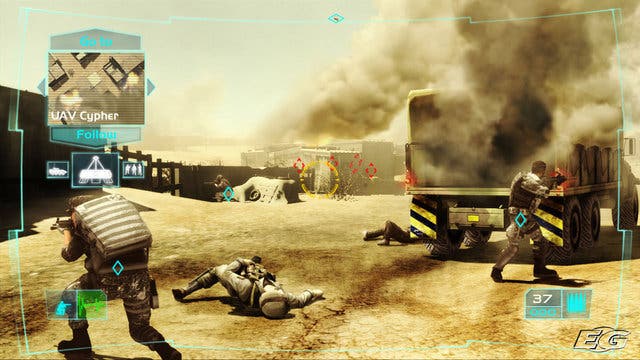Ghost Recon Advanced Warfighter 2
Give the people what they want.
You can say what you like about GRAW. Admire the lovely visuals, wax about the intuitive control system, or the tense duck and cover squad-based gameplay, but you can't say the single player portion was exactly polished. It had some of the most infuriating, sofa-punching difficulty spikes of any of the big games of 2006, with inconsistent checkpoint spacing, the worst night vision system of any game ever (seriously), ridiculous health issues, ammo problems, graphical glitches, you name it. There was a real feeling of the game being so close to greatness, but being rushed out before it was ready. Happily, almost every single thing that we complained bitterly about last year's version has been fixed. In many respects, GRAW 2 is the game that last year's version could and perhaps should have been - though this is an admittedly shorter game than last year's.
In the 'fixed' column there are an extraordinary number of improvements which make a vast difference to the enjoyment levels over the course of the game. For a kick off, the game now looks superb all the way through, with not a single hint of a glitch, bug, or any of the general craziness that seemed to routinely affect the original. Not only that, Ubisoft's Paris studio has gone even further in terms of creating the kind of gritty visual opulence that you expect from a next generation system. The general standard of the lighting and effects adds a host of subtle improvements to what was already one of the show-piece next generation titles. This isn't a title that will inspire moans about v-sync tearing or frame rate glitches - it's very much a sign of next generation game development moving to the next phase. Flying over entire cities, watching plumes of smoke billow out of ruined buildings has never looked so good.
Your feedback has been accepted

More significantly, Ubi has really listened to a whole host of complaints. Perhaps our chief bugbear about the original was the check pointing, and the fact that sometimes it'd expect the player to wage war for an obscene amount of time before deigning to save your progress. Hand in hand with that is the fact that you now have a medic on hand to help you out on a limited number of occasions when the battle turns up the heat. Previously, you would be able to heal others an unlimited number of times, but not yourself, which meant you'd often find yourself facing the last portion of the battle with next to no health - making thing unnecessarily tough for you. This simple gameplay tweak has eliminated this needless frustration at a stroke, and instead allowed Ubi to deliver a game that's both challenging and fair.
Night vision, as well, has been completely overhauled, and makes a dramatic difference to the playability during the phases of the game when you're playing in gloomy lighting. Despite the events of the game taking place a day after last year's Mexican adventure (which, for the record was set in 2014), the Ghosts' Cross Com 2.0 system utilises a sort of brightened negative effect when flicking to night vision. Like a clearer version of the system we're used to in the Splinter Cell games, it gives you an instant advantage in the dark and makes the darker portions of the game thoroughly enjoyable.
Ubi has also ensured that downed enemies stick around for longer, allowing you to scavenge for ammo when you need to, though they still vanish once you get far enough away from them, On the other hand, we'd still like to know why the corpses disappear from the battlefield at all, when it's pretty obvious that their dropped weaponry might come in useful at some point. Clearly it's a memory saving trick that developers like to use, but if Doom (from 1994) can do it, why the bleedin' hell can't this one? Maybe next year they'll get around to fixing this little quibble. In the meantime, though, the presence of a mobile ammo/health unit called a 'Mule' can be called upon now and then to follow you around - but it's not something you can always rely upon.
No going back

Strangely, Ubi still doesn't believe in allowing you to load in a previous checkpoint if you want to, meaning that you have to go back and play through a level from the beginning if you've missed a secondary objective. A small, but significant point if you're keen to gain all the achievements that the game offers.
On the whole, though, the game plays magnificently. Offering more variety and tactical depth than Gears of War, a more intuitive control system and more open-ended levels, it deserves warm applause for taking a linear approach while letting the player think for themselves. On the surface, the duck and cover gameplay shares more than a few similarities to Epic's huge-selling shooter, but scratch the surface and there are more than enough differences that allow GRAW 2 to stand out in its own right.
The general premise is pretty consistent throughout: simply head in the general direction of an objective marker (displayed as a yellow square on the tactical map, and as a position relative arrow on the screen) and take out any enemies you come across on your travels. Sometimes you might have to do this on your own, but mostly you're accompanied by up to three squad members who you can direct as you see fit. Sometimes you might just want to have them following you, while other times you might want to send them off to cover a particular area while you outflank your unwary foe. By simply issuing basic 'go to' or 'attack' commands with the dpad and pointing your reticule at what or where you want them to go, it's a system that hasn't really been bettered by a console game.


